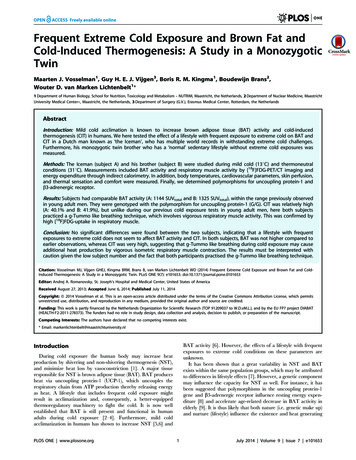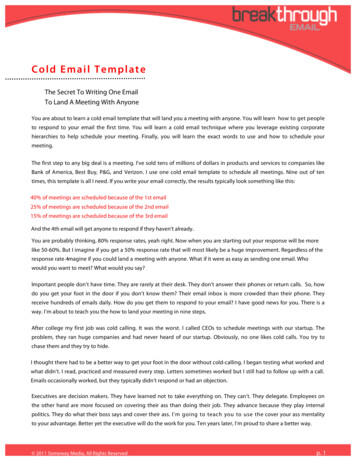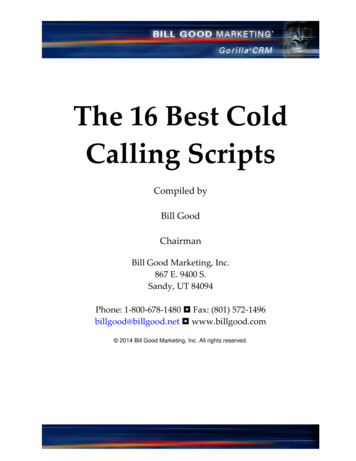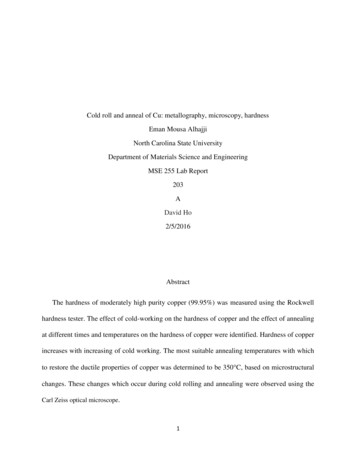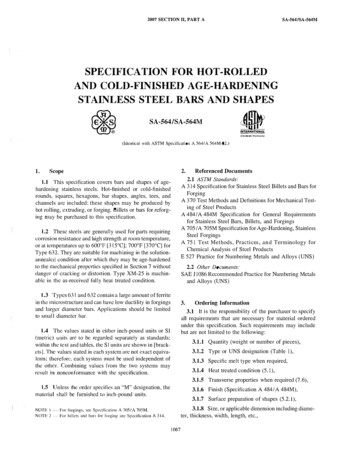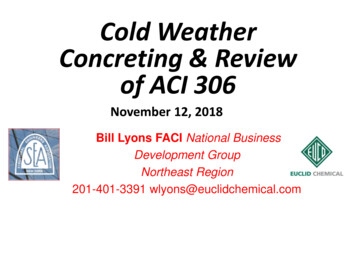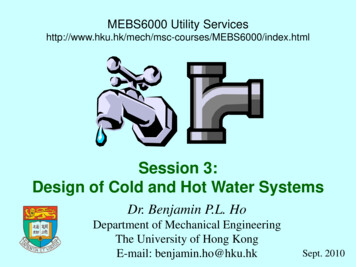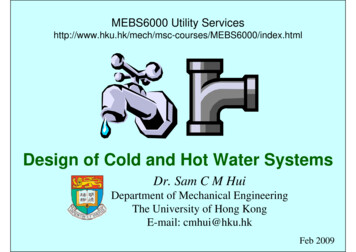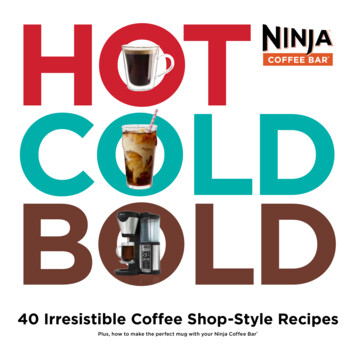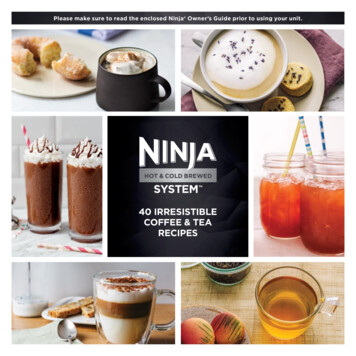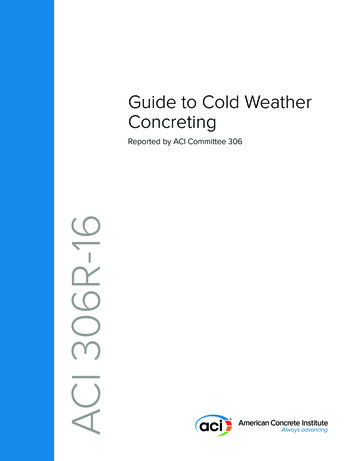
Transcription
Guide to Cold WeatherConcretingACI 306R-16Reported by ACI Committee 306
First PrintingSeptember 2016ISBN: 978-1-945487-15-6Guide to Cold Weather ConcretingCopyright by the American Concrete Institute, Farmington Hills, MI. All rights reserved. This materialmay not be reproduced or copied, in whole or part, in any printed, mechanical, electronic, film, or otherdistribution and storage media, without the written consent of ACI.The technical committees responsible for ACI committee reports and standards strive to avoidambiguities, omissions, and errors in these documents. In spite of these efforts, the users of ACIdocuments occasionally find information or requirements that may be subject to more than oneinterpretation or may be incomplete or incorrect. Users who have suggestions for the improvement ofACI documents are requested to contact ACI via the errata website at px. Proper use of this document includes periodically checking for errata for the mostup-to-date revisions.ACI committee documents are intended for the use of individuals who are competent to evaluate thesignificance and limitations of its content and recommendations and who will accept responsibility forthe application of the material it contains. Individuals who use this publication in any way assume allrisk and accept total responsibility for the application and use of this information.All information in this publication is provided “as is” without warranty of any kind, either express orimplied, including but not limited to, the implied warranties of merchantability, fitness for a particularpurpose or non-infringement.ACI and its members disclaim liability for damages of any kind, including any special, indirect, incidental,or consequential damages, including without limitation, lost revenues or lost profits, which may resultfrom the use of this publication.It is the responsibility of the user of this document to establish health and safety practices appropriateto the specific circumstances involved with its use. ACI does not make any representations with regardto health and safety issues and the use of this document. The user must determine the applicability ofall regulatory limitations before applying the document and must comply with all applicable laws andregulations, including but not limited to, United States Occupational Safety and Health Administration(OSHA) health and safety standards.Participation by governmental representatives in the work of the American Concrete Institute and inthe development of Institute standards does not constitute governmental endorsement of ACI or thestandards that it develops.Order information: ACI documents are available in print, by download, on CD-ROM, through electronicsubscription, or reprint and may be obtained by contacting ACI.Most ACI standards and committee reports are gathered together in the annually revised ACI Manual ofConcrete Practice (MCP).American Concrete Institute38800 Country Club DriveFarmington Hills, MI 48331Phone: 1.248.848.3700Fax: 1.248.848.3701www.concrete.org
ACI 306R-16Guide to Cold Weather ConcretingReported by ACI Committee 306William J. Lyons III, ChairKim D. BashamJames R. Baty IIMichael Patrick BerryCharles D. BinkowskiKen CannellaTerry C. CollinsKevin A. MacDonald, Vice ChairD. Gene DanielDavid J. ElmerMario GarzaJohn P. GnaedingerRobert J. HoopesKenneth C. HoverEric D. KingRonald L. Kozikowski Jr.Steve R. Lloyd Sr.Michael J. MarcheseStephen C. MorricalCraig M. NewtsonErik Holck, SecretaryWilliam D. Palmer Jr.Dennis R. PurintonDomenick Thomas RutturaValery TokarConsulting MembersTerry L. LavyRobert J. RyanHarold B. WenzelSixin YangVictor I. SubkovThis document guides specifiers, contractors, and concreteproducers through the selection processes that identify methods forcold weather concreting. The objectives of cold weather concretingpractices are to: a) prevent damage to concrete due to freezing atearly ages; b) ensure that the concrete develops the recommendedstrength for safe removal of forms; c) maintain curing conditionsthat foster normal strength development; d) limit rapid temperature changes; and e) provide protection consistent with intendedserviceability of the structure. Concrete placed during cold weatherwill develop sufficient strength and durability to satisfy intendedservice requirements when it is properly proportioned, produced,placed, and protected.CHAPTER 2—NOTATION AND DEFINITIONS, p. 22.1—Notation, p. 22.2—Definitions, p. 3CHAPTER 3—OBJECTIVES, PRINCIPLES, ANDECONOMY, p. 33.1—Objectives, p. 33.2—Principles, p. 33.3—Economy, p. 4CHAPTER 4—GENERAL RECOMMENDATIONS,p. 44.1—Planning, p. 44.2—Protection during unexpected freezing, p. 44.3—Concrete temperature, p. 44.4—Temperature records, p. 44.5—Heated enclosures, p. 54.6—Slab finishing, p. 54.7—Concrete workability, p. 5Keywords: accelerating admixtures; antifreeze admixtures; cold weatherconcreting; concrete temperature; curing; enclosures; form removal;freezing and thawing; heaters; heating aggregates; insulating materials;maturity testing; protection; strength development.CONTENTSCHAPTER 1—INTRODUCTION AND SCOPE, p. 21.1—Introduction, p. 21.2—Scope, p. 2CHAPTER 5—TEMPERATURE OF CONCRETEAS MIXED AND PLACED, AND HEATING OFMATERIALS, p. 55.1—Placement temperature, p. 55.2—Mixing temperature, p. 65.3—Heating mixing water, p. 65.4—Heating aggregates, p. 65.5—Steam heating of aggregates, p. 7ACI Committee Reports, Guides, and Commentaries areintended for guidance in planning, designing, executing, andinspecting construction. This document is intended for the useof individuals who are competent to evaluate the significanceand limitations of its content and recommendations and whowill accept responsibility for the application of the material itcontains. The American Concrete Institute disclaims any andall responsibility for the stated principles. The Institute shallnot be liable for any loss or damage arising therefrom.Reference to this document shall not be made in contractdocuments. If items found in this document are desired bythe Architect/Engineer to be a part of the contract documents,they shall be restated in mandatory language for incorporationby the Architect/Engineer.ACI 306R-16 supersedes ACI 306R-10 and was adopted and published September2016.Copyright 2016, American Concrete Institute.All rights reserved including rights of reproduction and use in any form or byany means, including the making of copies by any photo process, or by electronicor mechanical device, printed, written, or oral, or recording for sound or visualreproduction or for use in any knowledge or retrieval system or device, unlesspermission in writing is obtained from the copyright proprietors.1
2GUIDE TO COLD WEATHER CONCRETING (ACI 306R-16)5.6—Overheating of aggregates, p. 75.7—Calculation of mixture temperature, p. 75.8—Temperature loss during delivery, p. 7CHAPTER 6—PREPARATION BEFORECONCRETING, p. 86.1—Preparation of surfaces in contact with freshconcrete, p. 86.2—Massive metallic embedments, p. 86.3—Subgrade condition, p. 8CHAPTER 7—PROTECTION AGAINSTFREEZING FOR CONCRETE NOT REQUIRINGCONSTRUCTION SUPPORTS, p. 87.1—Protection methods, p. 87.2—Protection period, p. 97.3—Protection period for durability, p. 97.4—Protection for strength gain, p. 97.5—Temperature drop after removal of protection, p. 97.6—Allowable temperature differential during stripping,p. 10CHAPTER 8—PROTECTION AGAINST FREEZINGFOR STRUCTURAL CONCRETE REQUIRINGCONSTRUCTION SUPPORTS, p. 108.1—Introduction, p. 108.2—Field-cured cylinders, p. 108.3—In-place testing, p. 108.4—Maturity testing, p. 108.5—Attainment of design strength, p. 128.6—Increasing early strength, p. 128.7—Cooling concrete, p. 138.8—Estimating strength development, p. 138.9—Removal of forms and supports, p. 138.10—Estimating strength development: modeling coldweather placements, p. 14CHAPTER 9—EQUIPMENT, MATERIALS, ANDMETHODS OF TEMPERATURE PROTECTION, p. 149.1—Introduction, p. 149.2—Insulating materials, p. 149.3—Selection of insulation when supplementary heat isnot used, p. 149.4—Selection of insulation for use with hydronic heaters,p. 199.5—Heaters, p. 199.6—Enclosures, p. 199.7—Internal heating, p. 209.8—Temperature monitoring, p. 209.9—Temporary removal of protection, p. 209.10—Insulated forms, p. 20CHAPTER 10—CURING RECOMMENDATIONSAND METHODS, p. 2010.1—Introduction, p. 2010.2—Curing during the protection period inside anenclosure, p. 2010.3—Curing following the protection period, p. 21CHAPTER 11—ACCELERATION OF SETTING ANDSTRENGTH DEVELOPMENT, p. 2111.1—Introduction, p. 2111.2—Accelerating admixtures, p. 2111.3—Cold weather admixture systems (CWASs), p. 2211.4—Rapid setting cements, p. 22CHAPTER 12—REFERENCES, p. 22Authored documents, p. 23CHAPTER 1—INTRODUCTION AND SCOPE1.1—IntroductionThe conditions of cold weather concreting exist when theair temperature has fallen to, or is expected to fall below,40 F (4 C) during the protection period. The protectionperiod is defined as the amount of time recommended toprevent concrete from being adversely affected by exposureto cold weather during construction. Concrete placed duringcold weather will develop sufficient strength and durabilityto satisfy the intended service recommendations when itis properly proportioned, produced, placed, and protected.The necessary degree of protection increases as the ambienttemperature decreases.Take advantage of the opportunity provided by coldweather to place low-temperature concrete. Concrete placedduring cold weather, protected against freezing, and properly cured for a sufficient length of time, has the potential todevelop higher ultimate strength (Klieger 1958) and greaterdurability than concrete placed at higher temperatures. It issusceptible to less thermal cracking than similar concreteplaced at higher temperatures.Refer to ACI 306.1 for cold weather concreting requirements in a specification format. The Mandatory ItemsChecklist in ACI 306.1 can be used to add appropriate modifications to the contract documents.This document guides the specifier, contractor, andconcrete producer through the recommendations that identify methods for cold weather concreting.1.2—ScopeThis guide discusses general recommendations, concretetemperature during mixing and placing, temperature lossduring delivery, preparation for cold weather concreting,protection requirements for concrete with or withoutconstruction supports, estimating strength development,methods of protection, curing recommendations, and admixtures for accelerating setting and strength gain includingantifreeze admixtures.The materials, processes, quality-control measures, andinspections described in this document should be tested,monitored, or performed as applicable only by individualsholding the appropriate ACI Certifications or equivalent.CHAPTER 2—NOTATION AND DEFINITIONS2.1—NotationM maturity factor, deg-hAmerican Concrete Institute – Copyrighted Material – www.concrete.org
GUIDE TO COLD WEATHER CONCRETING (ACI 306R-16) tatr TTaTcTd ToTsTwWa Wc Ws Ww Wwa Wws t ambient air temperature, F ( C)concrete temperature upon delivery to the jobsite, F ( C)concrete temperature, F ( C)coarse aggregate temperature, F ( C)cement temperature, F ( C)drop in temperature to be expected during a 1-hourdelivery time, F ( C). (This value should be addedto tr to determine the recommended temperature ofconcrete at the plant after batching.)datum temperature, F ( C)fine aggregate temperature, F ( C)temperature of added mixing water, F ( C)saturated surface-dry weight of coarse aggregate, lb(kg)weight of cement lb (kg)saturated surface-dry weight of fine aggregate, lb (kg)weight of mixing water, lb (kg)weight of free water on coarse aggregate, lb (kg)weight of free water on fine aggregate, lb (kg)duration of curing period at concrete temperature T,deg-h2.2—DefinitionsACI provides a comprehensive list of definitions throughan online resource, “ACI Concrete Terminology,” ItemID CT16.Definitions provided herein complement that resource.carbon monoxide—a colorless and odorless gas inthe exhaust of fossil-fuel heaters and internal combustionengines that can cause dusting of concrete surfaces that areless than 24 hours of age.cold weather—when air temperature has fallen to, oris expected to fall below, 40 F (4 C) during the protection period; protection period is defined as the time recommended to prevent concrete from being adversely affectedby exposure to cold weather during construction.freezing—the development of solid water ice within thepaste that disrupts the paste, causing frost lenses to developin the paste.hydronic heater—mobile energy-exchanging systemused to heat frozen ground, formwork, or concrete surfacesby pumping heated fluid through closed-circulation tubingand a heat exchanger.liquidus temperature—the minimum temperature atwhich all components of a solution can be in a liquid state.Below the liquidus temperature the mixture will be partly orentirely solid.maturity testing—tests performed to estimate in-placeconcrete strength using in-place concrete temperature historyand strength-versus-temperature history functions derivedfrom tests of concrete with comparable mixture proportions.protection—the materials and environmental conditionsin place to prevent concrete from being affected by exposureto cold weather.3CHAPTER 3—OBJECTIVES, PRINCIPLES, ANDECONOMY3.1—ObjectivesThe objectives of cold weather concreting practices are to:(a) Prevent damage to concrete due to early-age freezing.When no external water is available, the degree of saturationof newly placed concrete decreases as the concrete maturesand the mixing water combines with cement during hydration. Additionally, mixing water is lost to evaporation evenat cold temperatures. Under such conditions, the degree ofsaturation falls below the critical saturation. Critical saturation is the lev
American Concrete Institute 38800 Country Club Drive Farmington Hills, MI 48331 Phone: 1.248.848.3700 Fax: 1.248.848.3701 www.concrete.org. This document guides specifiers, contractors, and concrete producers through the selection processes that identify methods for File Size: 1MBPage Count: 6
